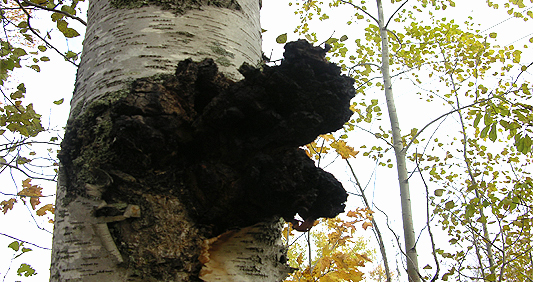|
Chaga Mushroom Guide Comprehensive and Complete Guide to Chaga Mushrooms |
|
ChagaWhat You Need To Know About ChagaChaga, also known as “Birch mushroom”, is a polypore fungus, which means that it has pores instead of the typical mushroom gills. It usually grows on birch trees and is considered among the top of the medicinal mushroom family. The color of this mushroom is black, with a cracked mass that is irregular in shape. Being a fungal parasite, it draws its food from the nutrients of the trees where it attaches itself. It grows in the wild and is not usually cultivated.
Chaga’s Natural Habitat Chaga’s History Chaga is used for the treatment of many forms of cancers and tumors in the Siberian regions. It is also used for treating digestive disorders as well as different kinds of bacterial and viral infections. The local people in the Siberian Mountains prepare it in powder form and drink it as tea. They also inhaled its smoke and apply it to their skin to heal their rashes and skin injuries. Due to their regular consumption of Chaga, these indigenous people have very low oncologic diseases. Many of them have been documented to live for over 100 years. But Chaga was completely unknown to the rest of the world until the famous author Alexander Solzhenitsyn mentioned it in his book “Cancer Ward”. In the book, he mentioned how Chaga was able to heal the cancerous diseases of some of the book’s characters. Today, Chaga is acknowledged as a “cancer-tumor herb” and is very much sought after in Asia and the rest of the world as a “cure-all” herbal medicine. Chaga’s Components The primary active ingredients of Chaga are special mushroom carbohydrates, also known as polysaccharides/beta-glucans. These substances can enhance the feel-good chemicals in the brain. They can also benefit the intestine, slow down digestion, boost liver function and increase energy. There is also a chemical substance called betuli/betulinic acid which can only be found in this mushroom specie. Research shows that betulinic acid can kill cancer cells without damaging normal cells. It was discovered recently that this substance has an inhibition effect on topoisomerase – the enzyme that regulates the over winding or under winding of our DNA strands. Combined with the actions of polysaccharides, Chaga is indeed a very potent agent that can be used as a dietary supplement to promote good health. Aside from these main active ingredients, Chaga also contains several phystosterols (mainly inotodiol and lanostero). This mushroom also contains high amounts of melanin which is a natural antioxidant. Melanin is also responsible for the black color, as well as giving it the highest antioxidant levels of all natural foods. How to Get the Best of Chaga |
|
© 2012 chagamushroomguide.com |
|
|
 Lifecycle of Chaga
Lifecycle of Chaga Digg
Digg Reddit
Reddit Stumbleupon
Stumbleupon Technorati
Technorati Twitter
Twitter Delicious
Delicious Blogmarks
Blogmarks BlinkList
BlinkList Diigo
Diigo Facebook
Facebook Fark
Fark Google Bookmarks
Google Bookmarks Livejournal
Livejournal Ma.gnolia
Ma.gnolia Netvouz
Netvouz Newsvine
Newsvine Spurl
Spurl Wists
Wists Yahoo My Web
Yahoo My Web